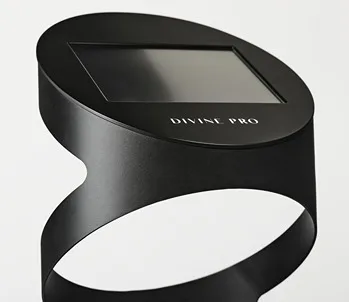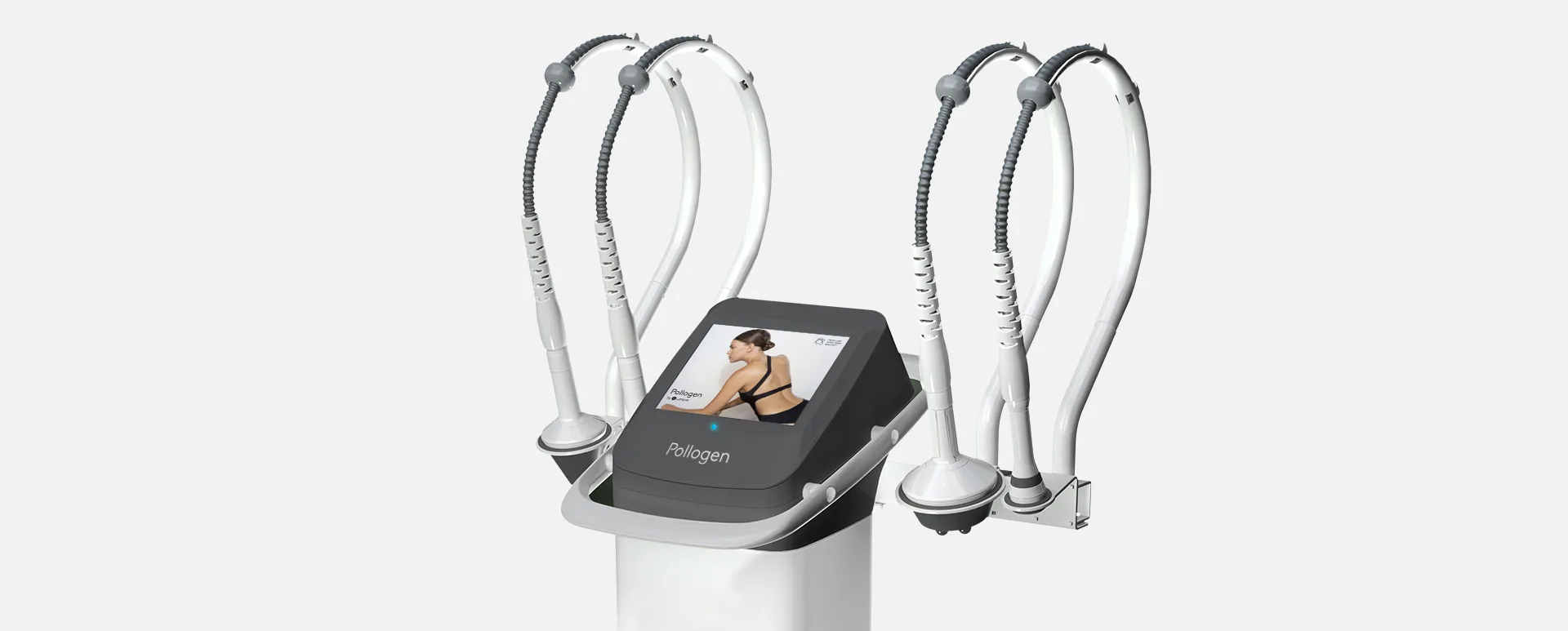Sehyun Kim, M.D., Lyhn Clinic, Seoul, Korea
Abstract
ABSTRACT:
Background It has been well established that Asian skin types are more sensitive to laser or IPL treatments (light-based treatments) due to a larger concentration of melanin in the skin. A new non-ablative treatment modality based on selective electro-heating, TriPollar™ RF Technology, was recently introduced aimed at skin tightening for skin laxity and circumference reduction on facial, neck and arm skin. As this new treatment does not utilize any type of light it is not skin color dependent and is wholly suitable for Asian skin types.
Objective This study aims to determine the clinical efficacy and safety of the non-ablative regen™ system, employing TriPollar RF technology, in the treatment of skin tightening and circumference reduction of facial, neck and arm skin in Asian skin types.
Method 100 Asian adult patients with lax and excess fatty facial, neck and arm skin were recruited for the study. Using the regen™ system, the patients underwent a regimen of one TriPollar RF treatment at weekly intervals. Throughout the study, before and after each treatment, the patient’s progress was photographically documented. Treatment continued until expectations were met. These results were evaluated during a final clinical assessment, which included patient self-assessment as well.
Results Immediate visible results were noticed from the first treatment. As seen in the photographs below (fig. 7), the patient’s results, observed gradually over the full course of treatment, revealed a significant circumference reduction and observable lifting of sagging skin. The patient’s self-assessment after the full course of the treatment was “excellent”. This patient experienced no adverse side effects during or after any of the treatments. Further, throughout the study none of the patients experienced any need for downtime following the treatments.
Conclusions This clinical study concluded a very good overall improvement in skin laxity and circumference reduction with absolutely no downtime for any patients. The TriPollar RF treatments are safe and effective for skin tightening and circumference reduction on Asian skin types. Further studies are needed to optimize the number and frequency of treatments.
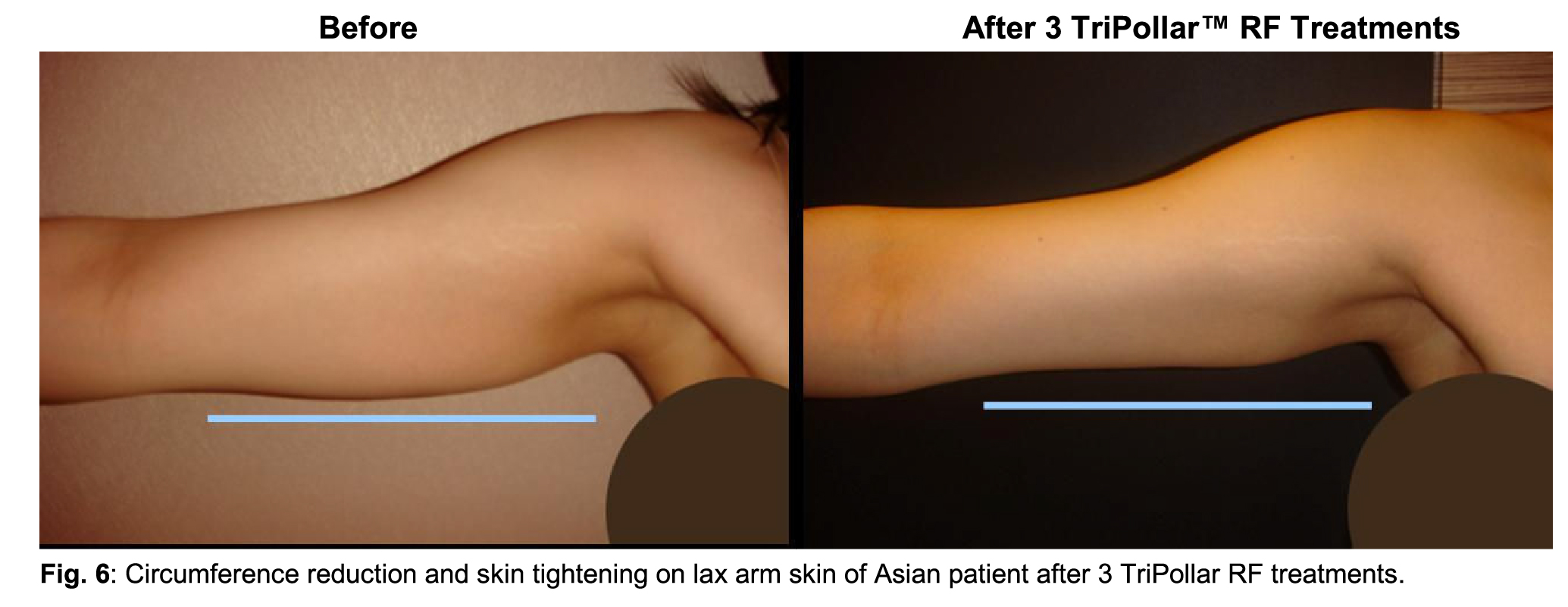
INTRODUCTION
Laxity of facial, neck and arm skin is a common cosmetic complaint of patients as they age. Although dramatic clinical improvement can be achieved on facial areas with surgical lifting procedures, the treatment of lax skin on arms remains unresolved.
Ablative laser skin resurfacing is a well-accepted treatment modality for facial rejuvenation because of its ability to improve, as expected, the appearance of photo-induced wrinkles. However, Asian patients may be hesitant to pursue this treatment option because of the extended post-operative recovery period and the inherent risks of the procedure on Asian skin types.
Non-ablative lasers and IPLs have demonstrated efficacy on Caucasian skin types, but this treatment modality is associated with an increased number of side effects on Asian skin types. Therefore, the development of a truly non-invasive, skin color-independent, deep tissue tightening on Asian facial, neck and arm skin continues to interest cosmetic surgeons and the Asian public alike.
Recently, a novel system (regen™ powered by TriPollar RF technology, manufactured by Pollogen Ltd.) was developed to deliver the effects of Radio Frequency (RF) energies in a non-ablative treatment for all skin colors. This unique 3rd generation RF system is based entirely on different technology than previous generation RF systems, heating simultaneously superficial and deep skin layers by delivering very focused RF current into the skin.
Radiofrequency energy for medical procedures has been used for many years. When applied to tissues between two electrodes the RF current generates heat through resistance of the dermis and subcutaneous tissue. This source of heat has been extensively used in surgery for hemostasis and tissue ablation (electro-surgery), but more recently it has been applied as a means of shrinking redundant or lax connective tissues through the mechanism of collagen denaturation. Collagen molecules are produced by fibroblasts which synthesize three polypeptide chains that wrap around one another in a triple helix. The phenomenon of thermal shrinkage of collagen begins with the denaturization of the triple helix of the collagen molecule. When collagen is heated, the heat-labile intra-molecular cross-links are broken, and the protein undergoes a transition from a highly organized crystalline structure to a random, gel-like state (denaturation). Collagen shrinkage occurs through the cumulative effect of the “unwinding” of the triple helix, due to the destruction of the heat-labile intra-molecular cross-links, and the residual tension of the heat-stable intermolecular cross-links (Ref 1). Heated fibroblasts are also implicated in new collagen formation and subsequent tissue remodeling which can also contribute to the final cosmetic result. The precise heat-induced behavior of connective tissues and the extent of tissue shrinkage are dependent on several factors which include the maximum temperature reached, exposure time, tissue hydration and tissue age.
Radiofrequency energy can be applied to tissue between two points on the tip of a probe (bi-polar – 2nd generation RF technology) or between a single electrode tip and a grounding plate (mono-polar – 1st generation RF technology). Less current is required with a bi-polar device than with a mono-polar device to achieve the same effect, because the current passes through a much smaller volume of tissue. With a mono-polar RF device the penetration depth can be estimated as half the electrode size while for a bi-polar RF device, the penetration depth of electrical current can be estimated as half the distance between the electrodes (Ref 2).
The regen™ system is a radiofrequency device that uses a multiple-electrode, TriPollar™ configuration (see Fig 1). The TriPollar™ design, 3rd generation RF technology, is based on three (3) or more electrodes to deliver the focused RF current into the skin tissue (see Fig. 2).
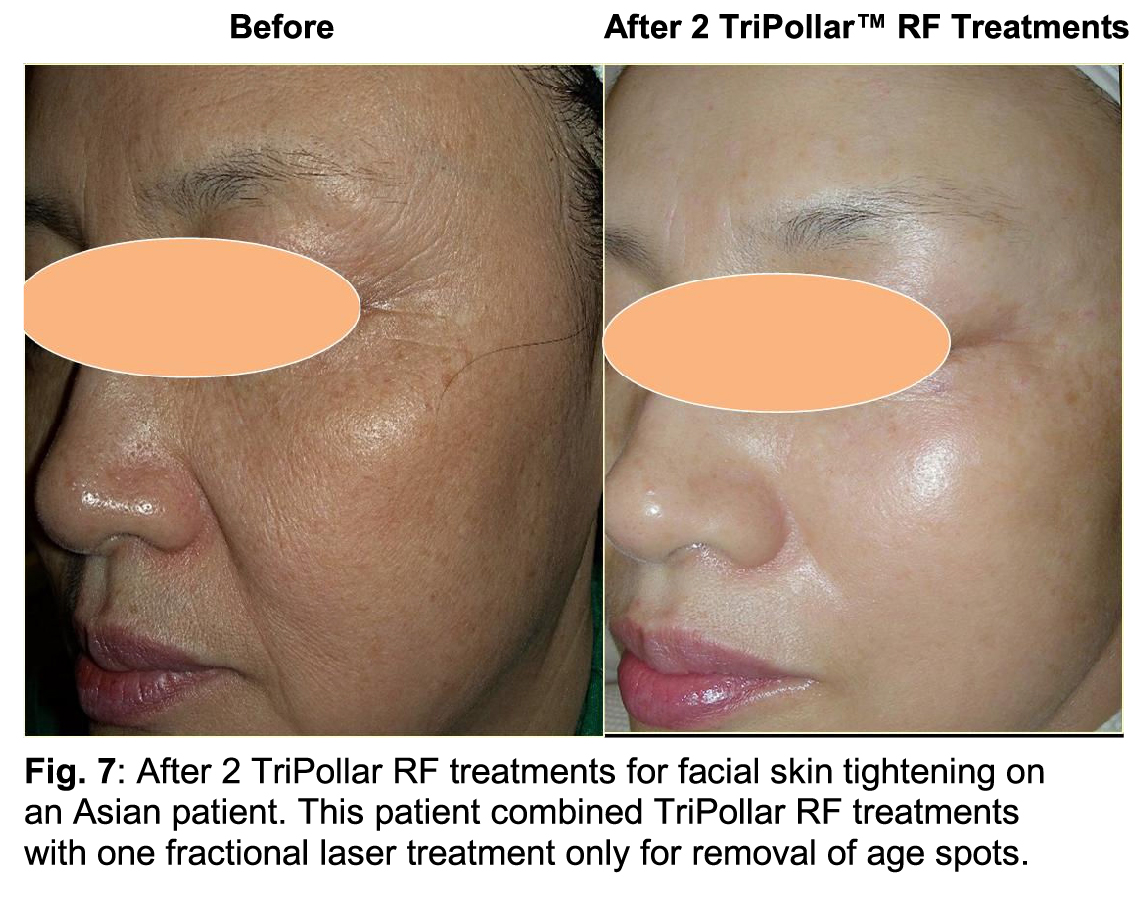
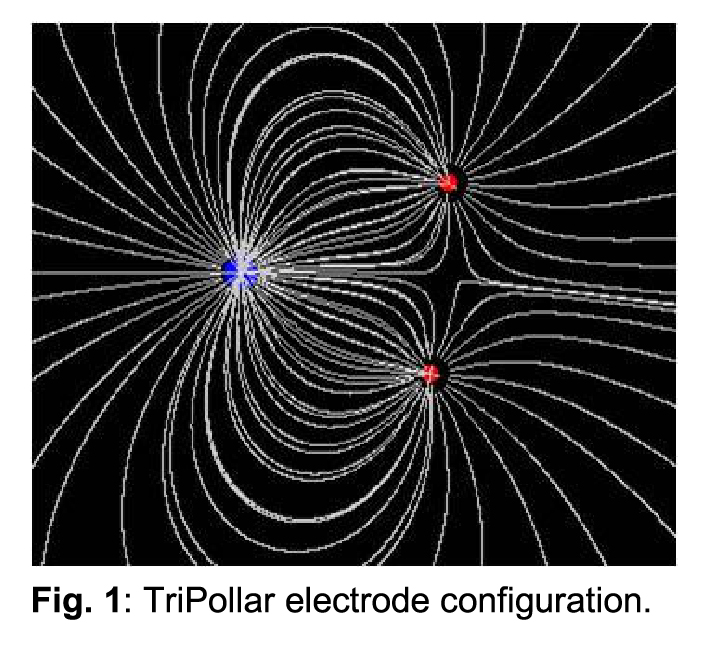
The depth of heat penetration is approximately the
average distance between the 3 electrodes and simultaneously heats the dermal and subcutaneous
layers (see Fig. 3).


Due to its design, no active cooling of the electrodes or
the skin is required. The regen™ system delivers RF energy at a frequency of 1 MHz and a maximum power
of 30 Watts. Two applicators are available for body
and face treatments (see Fig 4 & 5).
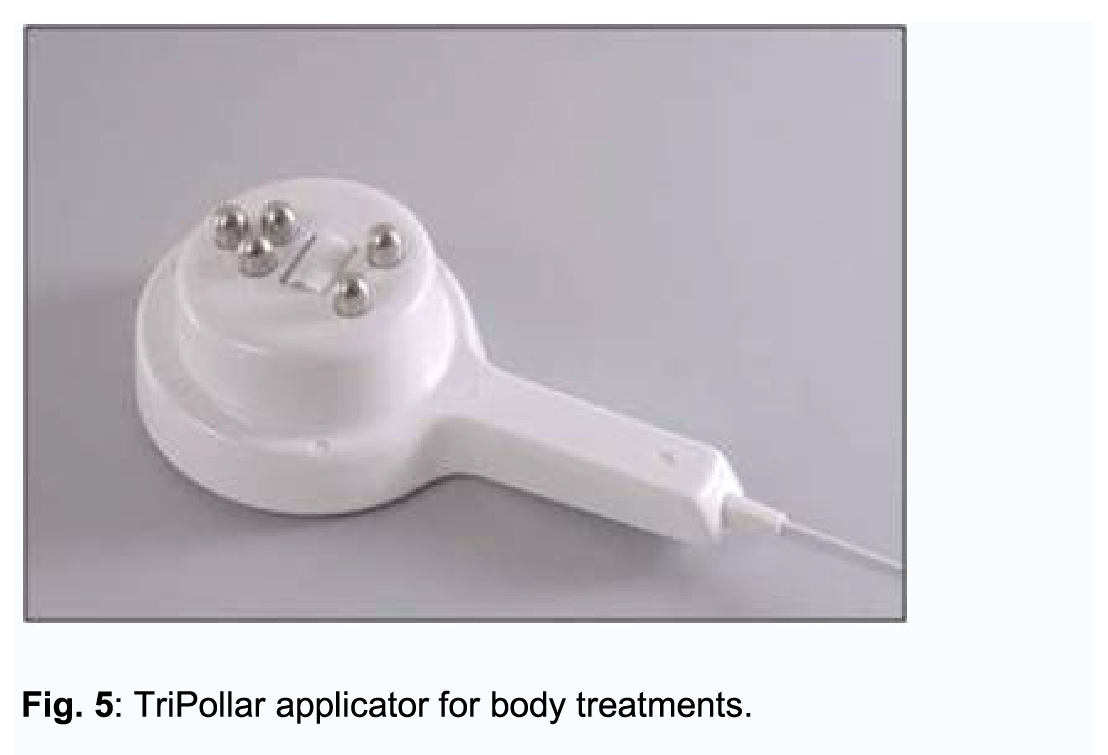
The system is indicated for the treatment of skin laxity, improvement of skin texture, treatment of cellulite, body contouring and localized fat reduction with immediate visible results for all skin colors without pain.
MATERIALS AND METHODS
The safety and efficacy of the regen™ system for the treatment of skin laxity and circumference reduction on Asian skin was evaluated at the Lyhn clinic in Seoul, Korea.
Patients underwent weekly treatment sessions and results were evaluated both quantitatively by measuring circumference and qualitatively through photography and a patient satisfaction questionnaire. Healthy female patients between the ages of 18-65 were enrolled in the study. Exclusion criteria include pregnancy, any implantable electronic device that could be disrupted by RF energy, and any active dermatological or collagen-vascular disorder. Patients completed a medical history form and signed an informed consent form prior to the commencement of the treatment course.
Prior to treatment all jewelry; necklaces, bracelets, watches, rings, etc. must be removed. The treatment area is then cleaned with soap and water and dried completely. Pretreatment photographs are taken and circumferences at specific reference points are measured. The treatment area is then lubricated with oil. The TriPollar™ applicator is positioned on the skin and the Foot Switch is pressed to begin treatment. During treatment, the applicator is applied with slight pressure and maneuvered in linear or circular massaging movements, depending on the area. Real-time treatment effects are monitored by both the patient and operator. The operator constantly monitors skin tightness, warmth and erythema, while periodically measuring skin temperature using a non-contact IR thermometer. Shortly after commencing treatment, there will be a noticeable tightening of the skin. Additionally, approximately three-quarters of the way through the treatment, erythema should be visible and the skin should be warm to the touch. Measured skin temperature should not exceed 420C.
TYPICAL RESULTS
In the last 4 months, 70 Asian patients underwent arm treatments and 30 Asian patients underwent facial treatments. All patients achieved excellent clinical results without adverse side effects. Arm Treatment: A normal-weight Asian woman with lax skin on the arms underwent 3 TriPollar™ treatment sessions on a weekly basis for the reduction in arm circumference and skin tightening (see Fig 6). With each treatment session, there was a gradual decrease in arm circumference, achieving a reduction of 15% in circumference after 3 treatments. The patient’s self-assessment of the results was graded “excellent”. The only side effect noted was erythema which resolved 1-2 hours after each treatment.
Face Treatment: A 63-year-old Asian woman underwent 2 TriPollar treatment sessions on her face for skin tightening and wrinkle removal, during which she had 1 fractional laser treatment for the removal of age spots (see Fig. 7). The combined treatment modalities resulted in excellent skin texture and a full reduction of the signs of aging. No side effects apart from transient erythema were noted.
SUMMARY
The regen TriPollar™ device is a multi-polar RF system which can safely and effectively be used for skin tightening and circumference reduction on Asian skin, particularly on the arms, neck and facial areas, as well as for the treatment of cellulite, reduction of localized fat, skin laxity and facial wrinkles. Application of this treatment modality is simple, non-invasive and extremely safe on all skin types. Qualitative as well as quantitative results have been documented and appear to be maintained long-term.
REFERENCES
1. Steven P. Arnoczky, DVM, and Alptekin Aksan,MS, “Thermal Modification of Connective Tissues: Basic Science Considerations and Clinical Implications”, J. of the American Academy of Orthopedic Surgeons, Vol.8, No. 5, p. 305, 2000
2. Neil S. Sadick, MD, FACP, FAACS and Yuriko Makino, MD, “Selective-Electro-Thermolysis in Aesthetic Medicine: A Review”, Laser in Surgery and Medicine 34:91-97, p.91, 2004







